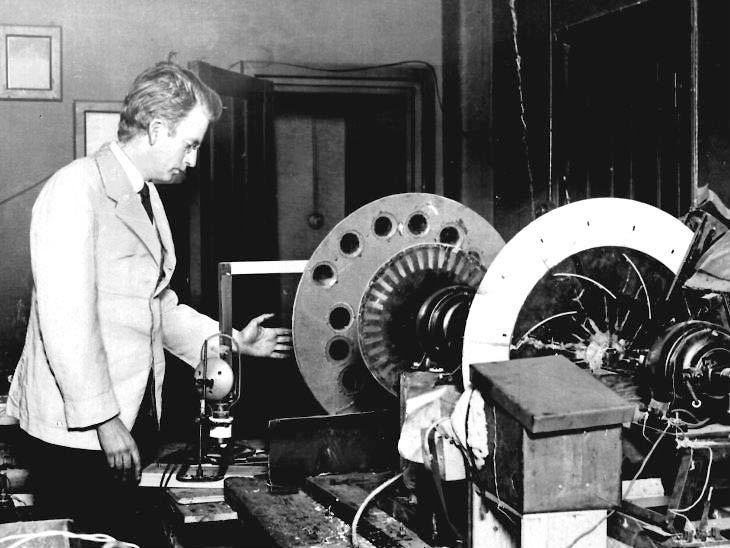Sony India today announced the launch of its new BRAVIA X75L 4K Ultra HD LED television series that is designed to provide its viewers with a personalized and true-to-life viewing experience. The X75L series comes with X1 4K Processor, Live Colour technology, X-Reality PRO, Motionflow XR, Dolby Audio, Clear Phase technology, Google TV, Apple AirPlay2 and HomeKit, Auto HDR Tone Mapping, Auto Genre Picture Mode, XR protection PRO.
XR, Dolby Audio, Clear Phase technology, Google TV, Apple AirPlay2 and HomeKit, Auto HDR Tone Mapping, Auto Genre Picture Mode, XR protection PRO.
Sony X75L 4K LED Television Series: Features & Sizes
The new X75L 4K televisions are available in four models- 108cm (43), 126cm (50), 139cm (55), 164cm (65). These next-generation televisions are powered by X1 Picture Processor which uses advanced algorithms to cut noise and boost detail. Live Colour technology provides vibrant, life-like color. The Motionflow XR creates and inserts extra frames between the original ones for smooth and sharp details in fast-moving sequences.
XR creates and inserts extra frames between the original ones for smooth and sharp details in fast-moving sequences.
Immersive Sound Experience & Gaming Features
The X75L also offers an immersive sound experience with clear and natural audio through open baffle-down firing twin speakers and Dolby Audio. It also comes with voice enabled remote and Google TV that offers 10,000+ Apps & games, 700,000+ movies and TV series, and live TV. It also works seamlessly with Apple AirPlay2 and HomeKit. The X75L series also offers gaming features that transforms the gaming experience with Auto HDR Tone Mapping and Auto Genre Picture Mode. It also features HDMI 2.1 compatibility with Auto Low Latency Mode (ALLM).
Sony X75L Price & Availabilty
The new BRAVIA X75L series is also designed to perform in the toughest conditions with XR protection PRO. It has a minimalist design with a narrow bezel and comes with a sleek smart remote to provide an immersive entertainment experience. The price of the X75L series starts from Rs. 69,900/- and they will be available from 24th April 2023 onwards.
- Show all
Experience Exceptional Picture Quality With Sony X1 4K HDR Picture Processor
The X80L series from Sony is a must-have for all entertainment enthusiasts. With its TRILUMINOS Pro display, experience life-like color and enjoy the thrills of cinema with Dolby Vision
Pro display, experience life-like color and enjoy the thrills of cinema with Dolby Vision and Dolby Atmos
and Dolby Atmos . The X-Balanced Speaker brings immersive sound experience that completes the movie theatre experience right in your home.
. The X-Balanced Speaker brings immersive sound experience that completes the movie theatre experience right in your home.
Google TV For Endless Entertainment
The X80L series offers a smart user experience with Google TV, which offers endless entertainment through 10,000+ apps & games along with 700,000+ movies and TV series. It also works seamlessly with Apple AirPlay2 and HomeKit. With the Handsfree voice search feature, you can interact with the TV to play your favorite shows and movies.
BRAVIA Core For IMAX Enhanced Movies
The X80L series now comes with BRAVIA CORE, enabling you to enjoy the largest collection of IMAX enhanced movies with the highest quality Pure Stream .
.
Gaming Mode For PS5
The X80L series offers a gaming mode for PS5 that transforms your gaming experience with Auto HDR Tone Mapping and Auto Genre Picture Mode. Its HDMI 2.1 compatibility supports gaming with Auto Low Latency Mode (ALLM). The Game Menu feature allows you easily access gaming status, settings, and gaming assist functions all in one place.
BRAVIA CAM and Ambient Optimization
Explore an array of fun new TV experiences with BRAVIA CAM including gesture controls, ambient optimization and Google meet etc. Experience supreme pictures and sound in every environment with Ambient optimization, Light sensor, and Acoustic auto calibration technology.
X-Protection PRO For Tough Conditions
X80L mind series is designed to perform in the toughest conditions with the X-Protection PRO. With flush surface design, slim T-shaped wedged stand and sleek smart remote with six hot keys, X80L seamlessly blends with your living room. It is also designed with the environment in mind.
Price and Availability:
| Model | Best Buy (in INR) | Availability Date |
| KD-43X80L | 99,900/- | 19th April 2023 onwards |
| KD-50X80L | 114,900/- | 19th April 2023 onwards |
| KD-85X80L | To be announced Soon | To be announced soon |
- Show all
Xiaomi Smart Air Purifier 4 Series and Robot Vacuum Mop 2i Price in India & Availability
The Xiaomi Smart Air Purifier 4 carries a price tag of Rs. 13,999 and will be available for an early sale via Mi.com and retail partners starting April 20. It will go on sale via Amazon from April 23. The Xiaomi Smart Air Purifier 4 Lite, on the other hand, is priced at Rs. 9,999. The early sale will start on Mi.com and retail partners starting April 20 and it will go on sale via Amazon and Flipkart from April 23.
The Xiaomi Robot Vacuum Mop 2i (Xiaomi RVC Mop 2i) comes with a price tag of Rs. 16,999. It will go on sale through Mi.com and retail stores from April 25 and will be available via Amazon starting April 28. Additionally, the Xiaomi Grooming Kit and Xiaomi Trimmer 2C are priced at Rs. 1,199 and Rs. 1,799, respectively. Early access sale of the grooming products started today at 4:00pm IST on mi.com. They will be up for sale on Flipkart, Amazon, and offline retail partners from April 16.
Xiaomi Smart Air Purifier 4 and Smart Air Purifier 4 Lite Features
The Xiaomi Smart Air Purifier 4 and Xiaomi Smart Air Purifier 4 Lite come with Triple Layer Filtration that is claimed to remove up to 99.97 percent of particles as small as 0.3 microns. They pack a negative ion generator for eliminating airborne particles including pollen, animal dander, dust, and mould spores. They come with 360° filtration and a True HEPA Filter.
Xiaomi’s Smart Air Purifier 4 is rated to offer a Particle Clean Air Delivery Rate (PCADR) of up to 400m3/h. It is said to be capable of circulating air of up to 516 square feet within 10 minutes. The toned-down model, Xiaomi Smart Air Purifier Lite, comes with a PCADR of up to 360m3/h and is said to deliver up to 6,000 litres of clean air per minute.
The new portable air purifiers feature OLED displays with two touch controls that give users a glimpse of particle pollution by showing PM 2.5 levels, temperature, humidity, and Wi-Fi connection. They can also be connected to the smart app with Google Assistant as well as Amazon Alexa. Moreover, the Xiaomi Smart Air Purifier 4 makes 32.1dB of noise, while the Xiaomi Smart Air Purifier 4 Lite has 33.4dB of noise. The former is said to consume 3W power in sleep mode.
Xiaomi Robot Vacuum-Mop 2i Specifications
The latest 2-in-1 robotic vacuum cleaner comes with cleaning and mopping capabilities and features 25 high-precision sensors including a wall sensor, collision sensor, cliff sensor, and wheel speed sensor among others. It has a height of 81.3mm.
The Xiaomi Robot Vacuum-Mop 2i uses 2,200Pa suction power and follows a zig-zag cleaning pattern. It includes a 450ml independent dust compartment. The battery is said to clean 1200 square feet in up to 100-minute run time.
Xiaomi Robot Vacuum-Mop 2i has remote control support and can be connected to the Mi Home app. Users can customize cleaning schedules, adjust cleaning modes and water levels, track device location, and more via the connected app. It supports Google Assistant as well as Amazon Alexa.
According to Counterpoint Research, over 99 percent of the TVs were assembled locally, while only some high-end TV sets were imported by the brands. Moreover, 96 percent of the market was driven by LED TVs, and MediaTek chips had around a three-fifths share of the total TV market during the year. The Smart TV contribution to overall shipments reached its highest-ever of 90 percent in 2022, and it is expected to go up further due to more launches in the sub-Rs. 20,000 price range and non-smart-TV-to-smart-TV migration.
The average selling price of Smart TVs declined 8 percent YoY to around Rs. 30,650, while Smart TV shipments in the Rs. 20,000-Rs 30,000 price band grew 40 percent YoY to reach a 29 percent share. The online channels increased their contribution to the total shipments to 33 percent during the year.
In conclusion, India witnessed a significant growth in Smart TV market in 2022 due to the festive season and multiple new launches, discount events, and promotions. The demand for bigger screen-size TVs in the lower price tier along with the high smart TV contribution to overall shipments is expected to drive the market further in the coming years.
Latest Deals & Offers:
Discover the Best Smart TVs for Your Home: From Top Brands to Budget-Friendly Options
When it comes to the best smart TVs in the USA, you have a choice of top brands, such as Samsung, LG, Sony, and Vizio. These companies offer a wide range of 4K Ultra HD TVs with advanced features, such as voice-activation and streaming services. Plus, there are budget-friendly smart TVs from other manufacturers, including TCL and Hisense. Whatever your budget, you’re sure to find a great smart TV.
Know Your Streaming Services: Unlock the Most Out of Your Smart TV
The other key factor to consider when shopping for a smart TV is the streaming services available. These days, most smart TVs come with built-in access to popular streaming services, such as Netflix, Hulu, and Amazon Prime. Some also offer access to more niche streaming services, such as HBO Now and ESPN+. Be sure to check which streaming services are available before you buy.
Once you’ve chosen the perfect smart TV for your home, you may want to accessorize it with the latest smart TV accessories, such as soundbars, gaming consoles, and streaming devices. You’ll also find a range of smart TV apps available, from popular streaming services to custom user interfaces.
The smart TV market is constantly evolving, with new technologies and content providers emerging all the time. To stay ahead of the curve, it’s important to keep up with the latest smart TV market trends. This includes keeping an eye out for the latest smart TV deals and discounts, as well as reading reviews and ratings on the latest smart TVs.
Finally, when it comes to smart TV compatibility, be sure to check that your new TV is compatible with other devices, such as streaming devices, gaming consoles, and media players. Different smart TVs use different operating systems, such as Android TV, so make sure they are compatible with your existing devices.
Enjoy the Ultimate Home Entertainment Experience with the Best Smart TV Deals and Discounts in the USA
Smart TVs offer the ultimate home entertainment experience, and with so many options available in the USA, you’re sure to find the perfect one for your home. Consider the features you need, from 4K Ultra HD to voice-activation and streaming services, then check out the best smart TV deals and discounts. Finally, make sure you know which operating system your TV uses and that it is compatible with other devices. With these tips, you’ll be sure to find the perfect smart TV for your home.
Latest Deals & Offers:
JioFiber Broadband Back-Up Plan
The JioFiber Broadband Back-Up plan can be availed for a minimum of five months at Rs 1490 (Rs 990 for five months and Rs 500 for installation). For the same, users will get unlimited data with a speed of up to 10 Mbps. In case you wish to use JioFiber if your primary broadband connection is down, then you can opt for the one-click speed upgrade for 1/2/7 days and increase the speed to either 30 Mbps or 100 Mbps. The cost of the one-speed upgradation is tabulated below.
| Pass Type | 30 Mbps | 100 Mbps |
| 1 Day | Rs 21 | Rs 32 |
| 2 Days | Rs 31 | Rs 52 |
| 7 Days | Rs 101 | Rs 152 |
In addition, JioFiber also brings a STB (Set-Top Box) upgrade option. For Rs 100 per month entertainment upgrade, users will get a free STB + 400 live TV channels + 6 OTT (over-the-top) apps + YouTube. For Rs 200 per month, users will receive a free STB + 550 live TV channels + 14 OTT apps + YouTube. Extra GST will be added to the bill.
How to Get JioFiber Broadband Back-Up Plan?
Users will need to give a missed call to 60008-60008, or they can visit the Jio website or the closest Jio retailer to purchase a back-up connection for Rs99. Jio representative proclaimed, “As India’s leading home broadband service provider, we at Jio comprehend the customer’s need to stay connected 24/7 with reliable broadband connectivity at home. With JioFiber Backup, we wish to offer an alternate dependable broadband connection for homes. This fresh concept of a back-up connection grants homes to have an alternate broadband connectivity with a guaranteed supply of data at a sensible cost.”
Latest Deals & Offers:
3D:
Standard 3D technology is a type of 3D technology used in many theaters and home entertainment systems to create the illusion of three-dimensional depth in a movie or other video content. It uses a process called stereoscopy, in which two slightly offset images are displayed on the screen, one for each eye. The viewer wears 3D glasses with polarized lenses, which allow each eye to see only the image intended for it, creating the illusion of depth.
IMAX 3D:
IMAX 3D is a type of 3D technology used in IMAX theaters to enhance the 3D movie-watching experience. It is designed to provide a more immersive and lifelike 3D experience by using larger screens, higher frame rates, and higher quality 3D glasses.
4DX:
4DX is a type of 3D technology that adds environmental effects, such as movement and scents, to the movie-watching experience. It uses special chairs that move and vibrate in sync with the action on the screen, as well as various other effects, such as wind, mist, and scents, to create a more immersive experience.
Overall, IMAX 3D is designed to provide a more immersive and high-quality 3D experience compared to standard 3D technology, while 4DX adds additional environmental effects to the movie-watching experience.
Latest offers on Smart TV:
According to the report, the advertising industry has lost 30 to 40 percent of the business this season. Many FMCG companies are withdrawing from advertising and are waiting for the situation to return to normal.
TV viewing time increased due to lockdown
- According to reports by television monitoring agency BARC (Broadcast Audience Research Council) and market research firm Nielsen, TV consumption time between March 21 and March 27 was at an all-time high of 1.2 trillium minutes. This is 37% higher than the pre-COVID period i.e. 11 to 31 January.
- As a result, the average daily FCT (free commercial time) of 21 to 27 March also increased by 6 lakh seconds i.e. a 15 percent increase. FCT grew the most in the food and beverages category, followed by personal care and hygiene products. (FCT means seconds purchased on the channel for advertisement)
- Chennai-based Ice Media director M Lawrence told that the reason for this increase in TV viewership is the lockdown. In such a situation, people are watching TV but without any interest. In such a situation, it will not prove much better for the advertising industry.
- Compared to last year, our business has decreased by 70-80%. We have also seen a fall in March and there is a possibility of further decline in April. We are advertising the food category, but have reduced the number of channels and are only focussing on the new channels.
Color TV arrived in India in 1982. Alam was that TV of 8 thousand rupees was ready to buy for 15 thousand rupees. As a result, the government imported 50,000 TV sets from abroad in 6 months. World Television Day was first observed on 21 November 1997 in the United Nations. On this occasion, you know some interesting stories of the journey of television …
TV set with wireless remote control arrived in 1955
First TV: TV made of sewing needle and fan motor
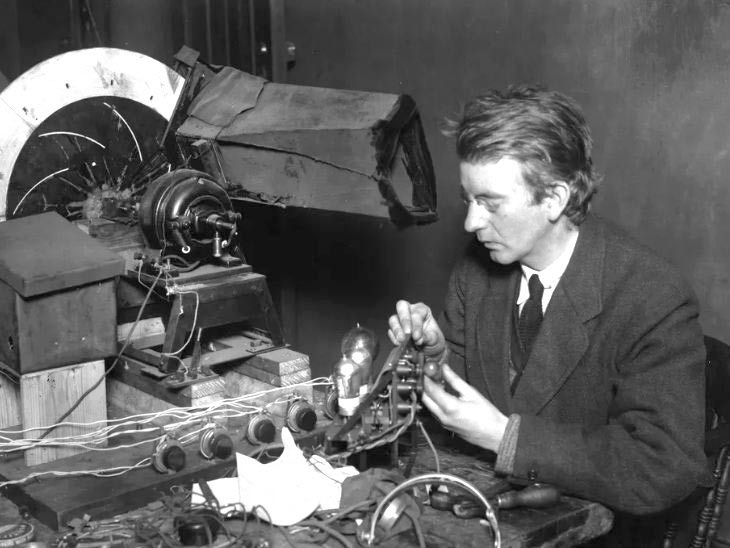
Television inventor John Logy Baird was often unable to attend school due to illness in childhood. Born in Scotland on 13 August 1888, Baird was so fond of telephones that at the age of 12 he developed his own telephone. Baird thought that there would be a day when people would be able to send pictures through the air. Baird made the first television in 1924 using boxes, boxes of biscuits, sewing needles, cards and motors with electric fans.
Television’s remote control was invented by Eugene Poli. Eugene Polly was born in 1915 in Chicago. He worked at Zenith Electronic. The first TV with remote control came on the market in 1950, its remote was connected to the TV set via a wire. A fully wireless remote control TV was introduced in 1955.
First advertisement: The company paid $ 9 for a 10-second advertisement
The world’s first commercial aired on 1 July 1941 in the US. The advertisement was given by the watchmaker Bulova. It was broadcast on the WNBT channel before a baseball match. The watch company paid $ 9 for this 10-second advertisement.

It was shown in the advertisement by placing the Bulova company watch with a map of America. The company’s slogan America Runs for Bulova Time was voiced with a picture of this wall clock placed on the map.
First color TV: Only 500 units were ready, the price was 6200 rupees.
In March 1954 Westinghouse produced the first color TV set. Initially, only 500 units were built. Its price at the time was around 6,200 rupees. That is to say that at that time it was out of the reach of common people.
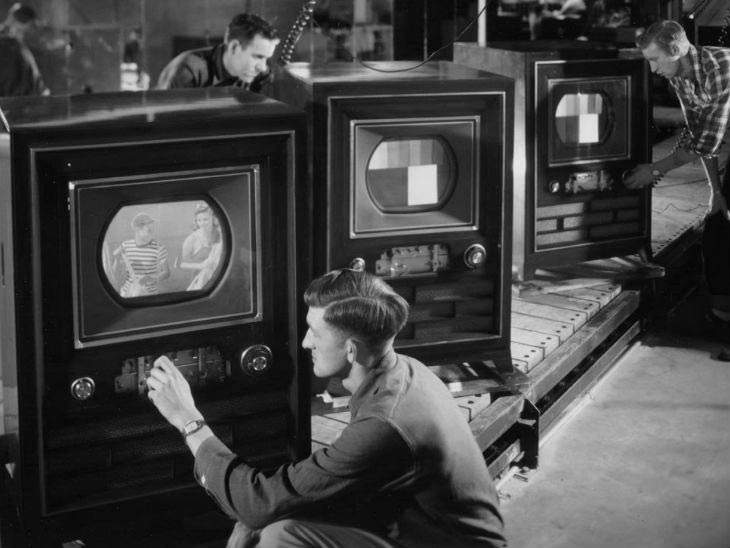
Shortly thereafter, American electronics company RCA introduced the color TV CT-100, the price was around 5 thousand rupees. The company had built its 4 thousand units. After this, the American company General Electronics introduced its 15-inch color TV, which cost about 5 thousand rupees.
India’s first buyer: Niyogi family of Kolkata bought
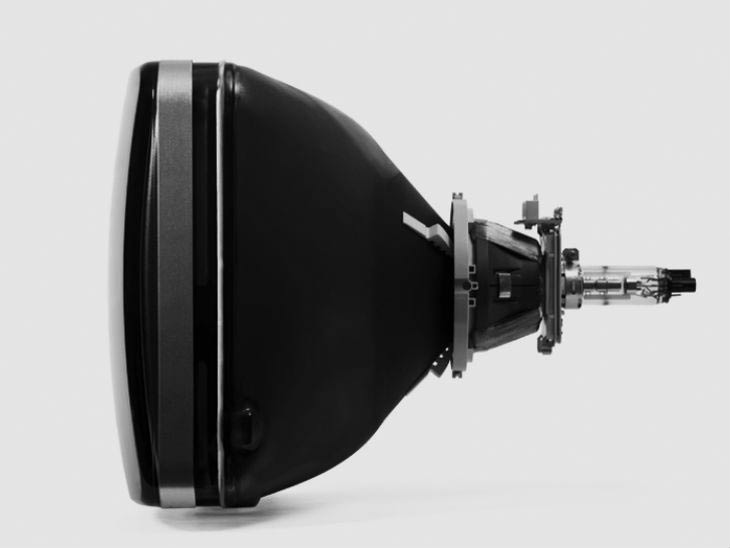
Electric engineering student B Sivakumaran introduced TV for the first time at an exhibition in Chennai. It was a TV with a cathode-ray tube. Although not broadcast via it, it was recognized as India’s first TV. The first television in India was bought by a wealthy Niyogi family from Kolkata.
For the first time: the curfew-like silence on the streets to watch TV in India
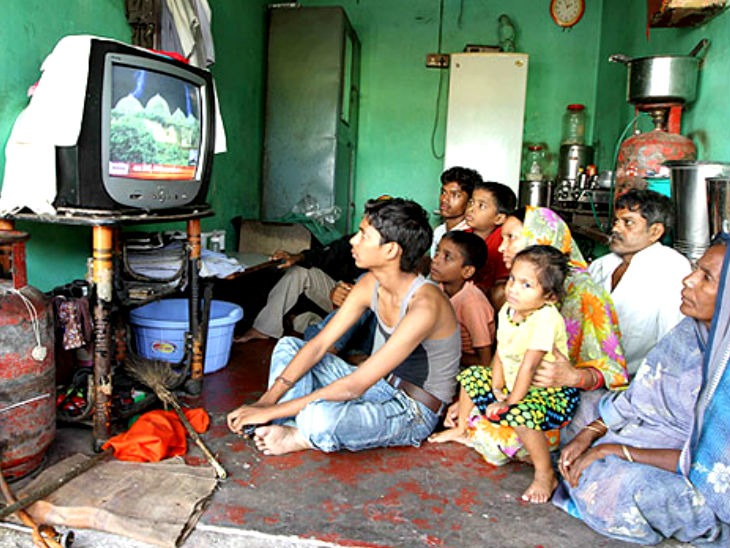
The story of television history in India starts with Doordarshan itself. Doordarshan was established on 15 September 1959. Even though there are thousands of channels on TV today, it is difficult to compete with the popularity that Doordarshan gained in that period. Doordarshan was earlier named ‘Television India’. In 1975, it was renamed in Hindi as ‘Doordarshan’. Initially, Doordarshan used to broadcast only half an hour for three days a week.
Doordarshan, which started in 1959, started airing daily in 1965. People were so excited to see serials like Ramayana and Mahabharata that started in 1986, during this time every Sunday morning there was a curfew-like silence on the roads across the country. Before the program started, not only did people clean their houses and wait for the Ramayana by lighting incense sticks and lamps, but also distributed prasad at the end of the episode.
First Bulletin: 1954 Bulletin read on TV
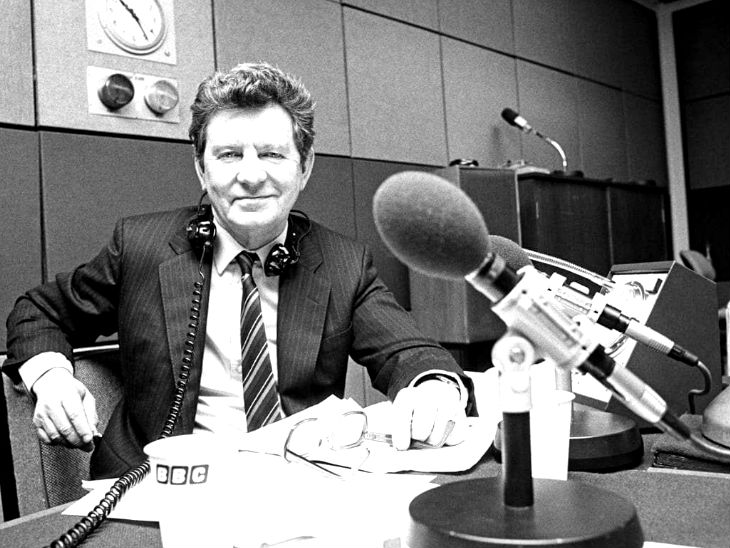
On 5 July 1954, the British Broadcasting Corporation (BBC) broadcast the Daily News Bulletin on television for the first time. During that time, only photos and maps were shown on TV instead of anchors. The reasoning was that seeing the face of a news anchor distracts people’s attention from a serious thing like news. At that time, this 20-minute news bulletin was read by Richard Backer. However, three years later, he got a chance to appear on the screen.
The post The first TV was made of cardboard and fan motor in 1924, the first commercial aired 17 years later. appeared first on Seven Sense Tech - Search | Compare | Best & Latest price of Smart TV, Soundbar, Smartphones, Gadgets & More.]]>Company specially created flim for this
- According to media reports, this TV’s display supports 64x pixels compared to regular 1080p HD TVs. This can be judged by the fact that many big photographs can be shown in this TV too.
- Its screen width is about two-storey building. Its size is quite large, many screens have been used to make it.
- Crystal LED technology has been used in it, in which multiple panels have been combined together into a single screen.
- This type of display technology is quite rare, for which creating content is very difficult. Specially for this, Sony has made a film in which the Wild Life is shown.
- Even before this, Sony has made a 16K pixel display, which was installed at a Tokyo airport in 2014, although it was clearly seen by seeing that it was built by connecting it with dozens of small screens.








